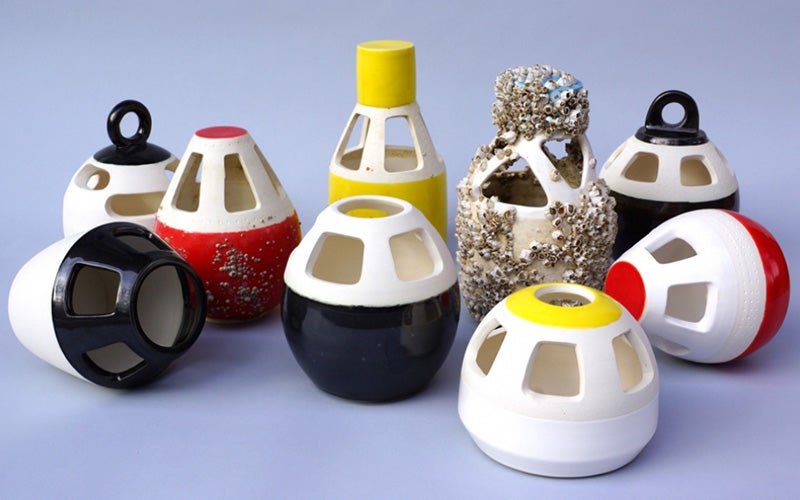Two very different research projects driven by A&AA faculty members have been awarded grants from the UO Idea awards program. While one project delves into the relationship between barnacle growth and ceramics, the other seeks to answer the microbial problem of poor indoor air quality.
Both the “Barnacle Project” and “Office Oasis” received $5,000 through the UO Idea grant program. The Product Design Program matched the funds.

Above: The Barnacle Project, coauthored by Product Design Assistant Professor Trygve Faste and Art Instructor Jessica Swanson, experiments with the design potential of ceramic ware encrusted with barnacle growth. Photo courtesy Trygve Faste.
Kiersten Muenchinger, director of the Product Design Program, says that both undertakings demonstrate how UO faculty members are “pushing boundaries of design and science.”
The Barnacle Project—coauthored by Assistant Professor Trygve Faste of the Product Design Program and Instructor Jessica Swanson from the Department of Art—experiments with the design potential of ceramic ware encrusted with barnacle growth.
“This is a challenging goal, as the barnacles are difficult to predict and it takes time to experiment with various ways of guiding and controlling their attachment to the ceramics,” said Faste. “In addition, there are many technical challenges with leaving ceramic pieces in the ocean for long periods of time and being able to recover and use them once they come out.”
Barnacles combine with the ceramic in a strong aesthetic and functional synthesis to create “conceptually meaningful ceramic forms,” according to the project’s grant proposal. “Ultimately, this project will continue to develop how design and art can be enhanced by understanding and incorporating other life forms.”
The proposal notes that “Barnacles have many interesting physical and aesthetic properties, including an exceptionally strong naturally secreted cement which rivals the best industrial epoxies. There is no doubt that the future of design will expand the idea of designing with living materials and systems.”
Last year, barnacle growth on wheel-thrown ceramic pieces was tested at the Oregon Institute of Marine Biology estuary. This project involves collaboration among UO’s Product Design Program, the UO Department of Art, and The Oregon Institute of Marine Biology. Students from these fields are hired to help with research.
“We are optimistic that we will not only discover a great deal more about the process, but also have some wonderfully encrusted ceramics in the end,” said Swanson.

Above: Office Oasis, cocreated by John and Wonhee Arndt, both assistant professors in the Product Design Program, focuses on resolving the issue of indoor air quality. Modern building materials contain volatile organic compounds (VOCs) that can trigger adverse health effects. Research at UO’s Biology and the Built Environment Center has suggested that interior design choices can positively influence the health of a building’s occupants.
“We are interested in designing modular plant-based systems to remediate [a building’s] VOCs and improve the microbial diversity to create a healthier indoor environment, designed in conjunction with office furniture systems that take a more user-friendly and human-centered design approach,” the grant proposal states.
The majority of the existing solutions use a plant wall system, a large and complex installation that requires maintenance. Office Oasis’s investigators plan to develop a product to address indoor air quality in the form of a modular product and furniture system. This product will contain a filtration unit, houseplants, and an integrated watering system that can be incorporated into tables, wall partitions, and furniture.
“We hope to achieve healthier work environments by integrating plant-based air filtration systems directly into the work environment,” Mr. Arndt wrote via email. “Certain plants have been proven to improve indoor air quality and remove and naturally break down harmful chemicals.”
Adding specific filters to the plants can augment their inherent properties. Activated charcoal and minerals like zeolite can absorb the harmful VOCs; microorganisms in the soil can break down these compounds into nutrition for the plant.
“The plant remediation system not only offers the functional effect of air remediation, it will also transform the office into a furniture landscape where occupants experience the feeling of working in a park-like environment,” the proposal states. “This will improve the well-being of office workers and work productivity.”
Prototype development and testing follow different stages of research, which explore how to integrate plant systems into the office environment. VOC remediation tests are being employed by UO architecture Professor Charlie Brown in the Energy Studies in Buildings Lab.
The Idea grant is a semi-annual award through UO Research Development Services. It is offered to UO faculty members interested in collaborative research projects. The competition for the grant, worth up to $5,000, occurs twice per academic year.
